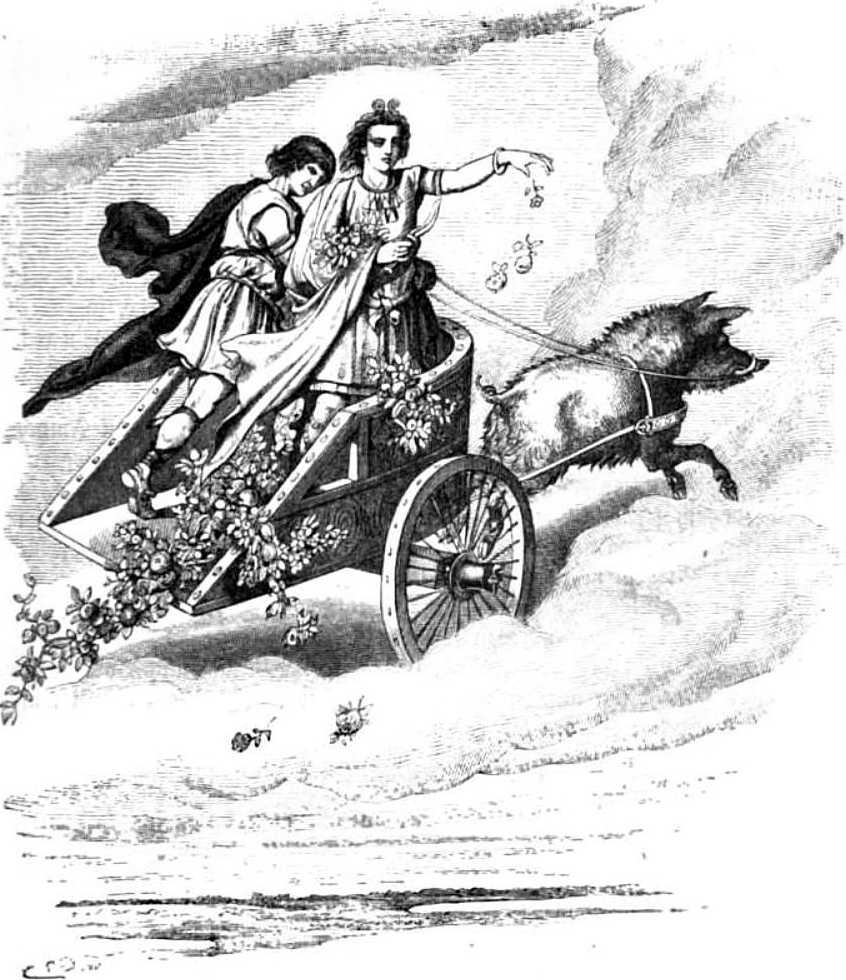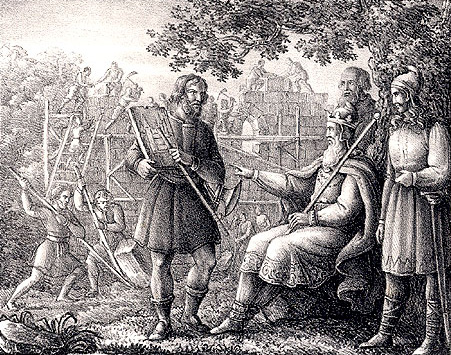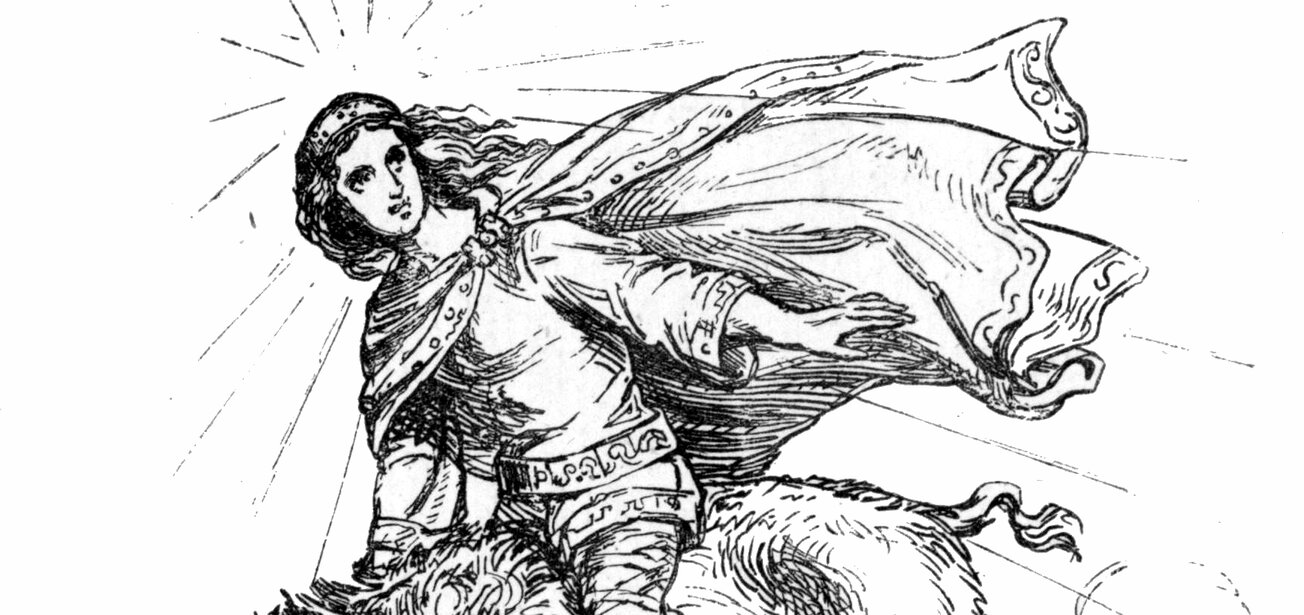The god Freyr was twin brother to his sister, the goddess Freyja. He succeeded his father as king of Sweden, was also well-loved, and presided over many bountiful harvests – indeed, his subjects believed he could control the weather and soil. Proof of Freyr’s association with fertility in Norse mythology is evident when you see many of his images feature a large phallus.
Of What Was Freyr a God?
Freyr (also spelled Frey) was also known as Yngvi. He was part of the Norse pantheon and the god of fertility, virility, and the weather. He also has influence over prosperity.
The Origin of the Word Freyr
The etymology of the Old Norse name Freyr (or “lord”) stems from the Proto-Germanic noun “frawjaz” or Old High German “frō,” meaning “lord.”
Scholars also believe that the name derives from the nominative of the Proto-Scandinavian adjective “fraiwi” or ”fraiwa,” meaning “fruitful.”
The Old Norse name “Yngvi” and the Old High German “Ing” or “Ingwi” are aliases of Freyr.
His name appears as Yngvi-Freyr in the Íslendingabók written in the early 12th century by the Icelandic priest Ari Þorgilsson and is the “ancestor of the Ynglings” (or Kings of Sweden).
What Symbol is Freyr?
Symbols associated with Freyr include a large phallus (a sign of virility), his magic sword, the boar Gullinbursti, the fine ship Skíðblaðnir and the sacred horses he kept at his halls in Trondheim.
Freyr has an association with the Ingwaz rune. The Proto-Germanic “Ingwaz” was the reconstructed name of the Elder Futhark rune “ᛜ” and Anglo-Saxon rune “ᛝ,” representing “ŋ.”
What is Freyr’s Weapon?
Freyr was the owner of a magical “sword of the gods” that came to life in the hand of someone it considered wise enough, wielding itself without any manipulation by the bearer.

Who Were the Members of Freyr’s Family?
Njord
Freyr’s father was the Vanir god Njord.
Njord lived in Nóatún (Old Norse: Njörðr; meaning: “ship-enclosure”). According to the Gylfaginning section of the 13th-century collection of Norse tales by the Islandic politician, historian, and poet Snorri Sturluson, Nóatún is a port located “in Heaven.”
Texts identify Njord with the sea and seafaring, the winds, wealth, and crop fertility. He also appears in the Poetic Edda, a series of poems compiled in the same century.
In another work by Sturluson, Njord appears as a beloved mythological early king of Sweden in Heimskringla, a book of tales about Norwegian and Swedish kings.
Abundant harvests, peace, and prosperity characterized Njord’s reign, so much so that the people believed he could control crops and wealth. His body was burnt in tribute by the Swedes when he died, and there was great mourning. Freyr succeeded him as reigning monarch.
Freyja
Freyja was the daughter of Njord.
Freyja or Freya was also from Vanaheim and was the most famous goddess in Viking society, along with Frigg. She was the masterful practitioner of magic called seiðr and the Norse goddess of love, fertility, beauty, sex, gold, and war.
Freyja’s powers are typical of Vanir gods: gentle and related to agriculture, magic, and love. She had two daughters with her husband, Óðr: Gersemi and Hnoss.
Mother
Freyr’s mother was unknown, but the ancient Germanic goddess Nerthus has semantic connections with Njord.
The name Nerthus resembles the feminine form of Njord used around year one of the Common Era (or 1 AD).
Sources suggest this relationship may indicate an association between Njord and Nerthus, such as brother and sister. Therefore, Nerthus could be the unnamed sister who bears Freyja and Freyr, with Njord as the father.
Son – Fjölnir
Fjölnir became a legendary king in Norse mythology.
What Is The Story of Freyr?
Freyr and his sister Freyja accompanied their father to live in Asgard as a part of the accords after the Æsir-Vanir War. These accords banished certain Vanir to live in Asgard in exchange for several Æsir moving to Vanaheim.
Freyr succeeded his father as king of Sweden, was also well-loved, and presided over many bountiful harvests. Proof of Freyr’s association with fertility and virility is evident when you see many of his images feature a large phallus.
The gods made Freyr ruler of the elf kingdom, Alfheim. He rode the golden-bristled boar Gullinbursti, created by dwarves, and owns the ship Skíðblaðnir, described as the finest vessel ever constructed. Skíðblaðnir always finds good winds and can fold away into a bag when necessary!
Freyr fell in love with the jötunn Gerðr (or Gerd) after she lit up the entire world on their first meeting. However, he had to relinquish his magic sword to become her husband.
Freyr bred divine horses at his hall at Trondheim, Norway, where his servants Beyla, Byggvir, and Skírnir kept house. Freyr’s horse is called Blóðughófi (Bloody hoof in Old Norse).

Poetic Edda Attestations
Skírnismál
In the poem Skírnismál, Freyr sent his servant Skírnir to Jotunheim to manage his courting of the giant goddess Gerðr, daughter of Gymir. Skírnir agreed if Freyr gave him his magic sword as a reward.
The giantess refuses the servant’s requests until he uses his magic wand to convince her. Without his magic sword to help him, Freyr had to improvise in a fight with the jötunn Beli and kill him with an antler.
Lokasenna
In Lokasenna, Loki taunts Njord about fathering Freyr with his sister, Freyja.
Völuspá
In Völuspá, the most famous Eddic poem, we read about the climatic confrontation between the fire giant Surtr and Freyr during Ragnarök:
Surtr moves from the south
Surtr – Symbolism and Importance in Norse Mythology
with the scathe of branches:
there shines from his sword
the sun of Gods of the Slain.
Stone peaks clash,
and troll wives take to the road.
Warriors tread the path from Hel,
and heaven breaks apart.
Grímnismál
Grímnismál mentions that the gods gave Alfheim to Freyr:
Alfheim the gods to Frey
Freyr – Wikipedia
gave in days of yore
for a tooth-gift.
Prose Edda Attestation
Gylfaginning
The poem Gylfaginning from the Prose Edda by the Icelandic historian Snorri Sturluson attests to Gerðr thus:
There was someone called Gymir and his wife Aurboda. She was of the race of mountain giants. Gerðr is their daughter, the most beautiful of all women.
Aurboða – Wikious
In chapter 34, Skírnir also conducts tasks for Odin.
Chapter 24 provides us with this description of Freyr and Freyja:
Njördr in Nóatún begot afterward two children: the son was called Freyr, and the daughter Freyja; they were fair of face and mighty. Freyr is the most renowned of the Æsir; he rules over the rain and the shining of the sun, and therewithal the fruit of the earth; and it is good to call on him for fruitful seasons and peace. He also governs the prosperity of men.
Freyr – Rune Stone
Gesta Hammaburgensis Ecclesiae Pontificum Attestation
The Gesta Hammaburgensis Ecclesiae Pontificum, written around 1080 by Adam of Bremen, attests to Freyr but uses the Latin name “Fricco.”
Adam described a temple at Uppsala in Sweden and included details about Freyr and the other major Norse Gods.
In this temple, entirely decked out in gold, the people worship the statues of three gods in such wise that the mightiest of them, Thor, occupies a throne in the middle of the chamber; Woden (Odin) and Frikko have seats on either side.
Temple at Uppsala – World History
He went on to say:
Frikko, who bestows peace and pleasure on mortals. His likeness, too, they fashion with an immense phallus.
The Fair Face of Freyr – Germanic Mythology
Ynglinga Saga
The Ynglinga Saga, also by Sturluson, describes the most ancient part of the story of the House of Ynglings. The Ynglinga Saga is the first part of the Heimskringla, Sturluson’s history of the old Norse kings.
The tale describes how the Norse gods arrived in Scandinavia and how Freyr established the Swedish Yngling dynasty at Uppsala.

Does Freyr Survive Ragnarök?
The prophecy of Ragnarök decreed that Surtr would kill Freyr during this end of days.
How Was Freyr Worshipped?
The temple mentioned previously near Uppsala in Sweden was where worshippers would go to pay homage to Freyr. Records of pilgrimages and processions appear in texts about the god. Reports of these events mentioned effeminate men wearing bells and dancing in tribute.
Modern Morris dancers also wear bells and conduct an old ritual to prepare the earth for harvest (and fertility) by poking the ground with phallic poles.

